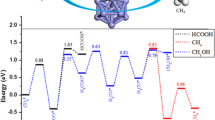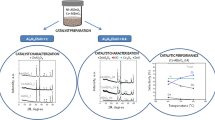Abstract
Indium oxide (In2O3) has demonstrated to be an effective non-noble metal catalyst for methanol steam reforming reaction (MSR). However, the reaction mechanism of MSR and crucial structure-activity relations determining the catalytic performance of In2O3 are still not fully understood yet. Using density functional theory (DFT) calculation, we systematically investigate the MSR process over a high-index In2O3(211) and a favoured catalytic cycle of MSR is determined. The results show that In2O3(211) possesses excellent dehydrogenation and oxidizing ability, on which CH3OH can readily adsorb on the In4c site and be easily activated by the reactive lattice oxygens, resulting in a total oxidation into CO2 rather than CO, while the H2 formation through surface H–H coupling limits the overall MSR activity because of the strong H adsorption on the two-coordinated lattice O (O2c). Our analyses show that the relatively inert three-coordinated lattice O (O3c) could play an important catalytic role. To uncover the influence of the local coordination of surface In atoms and lattice O on the catalytic activity, we evaluate the activity trend of several types of In2O3 surfaces including (211), (111), and (100) by examining the rate-limiting, which reveals the following activity order: (211)>(111)>(100). These findings provide an in-depth understanding on the MSR reaction mechanism over In2O3 catalysts and some basic structure-activity relations at the atomic scale, could facilitate the rational design of In2O3-based catalysts for MSR by controlling the local coordination environment of surface active sites.
Similar content being viewed by others
References
Muradov N, Veziroglu T. Int J Hydrogen Energy, 2008, 33: 6804–6839
Zhang S, Wang X, Xu X, Li P. Int J Hydrogen Energy, 2017, 42: 1932–1941
Xu X, Shuai K, Xu B. Catalysts, 2017, 7: 183–197
Palo DR, Dagle RA, Holladay JD. Chem Rev, 2007, 107: 3992–4021
Iulianelli A, Ribeirinha P, Mendes A, Basile A. Renew Sustain Energy Rev, 2014, 29: 355–368
Rodríguez-Lugo RE, Trincado M, Vogt M, Tewes F, Santiso-Quinones G, Grützmacher H. Nat Chem, 2013, 5: 342–347
Nielsen M, Alberico E, Baumann W, Drexler HJ, Junge H, Gladiali S, Beller M. Nature, 2013, 495: 85–89
Yu KMK, Tong W, West A, Cheung K, Li T, Smith G, Guo Y, Tsang SCE. Nat Commun, 2012, 3: 1230–1236
Kusche M, Enzenberger F, Bajus S, Niedermeyer H, Bösmann A, Kaftan A, Laurin M, Libuda J, Wasserscheid P. Angew Chem Int Ed, 2013, 52: 5028–5032
Rameshan C, Stadlmayr W, Weilach C, Penner S, Lorenz H, Hävecker M, Blume R, Rocha T, Teschner D, Knop-Gericke A, Schlögl R, Memmel N, Zemlyanov D, Rupprechter G, Klötzer B. Angew Chem Int Ed, 2010, 49: 3224–3227
Rameshan C, Stadlmayr W, Penner S, Lorenz H, Memmel N, Hävecker M, Blume R, Teschner D, Rocha T, Zemlyanov D, Knop-Gericke A, Schlögl R, Klötzer B. Angew Chem Int Ed, 2012, 51: 3002–3006
Liu Y, Hayakawa T, Suzuki K, Hamakawa S. Catal Commun, 2001, 2: 195–200
Men Y, Gnaser H, Zapf R, Hessel V, Ziegler C. Catal Commun, 2004, 5: 671–675
Friedrich M, Penner S, Heggen M, Armbrüster M. Angew Chem Int Ed, 2013, 52: 4389–4392
Yi N, Si R, Saltsburg H, Flytzani-Stephanopoulos M. Appl Catal B-Environ, 2010, 95: 87–92
Barbosa RL, Papaefthimiou V, Law YT, Teschner D, Hävecker M, Knop-Gericke A, Zapf R, Kolb G, Schlögl R, Zafeiratos S. J Phys Chem C, 2013, 117: 6143–6150
Liu D, Men Y, Wang J, Kolb G, Liu X, Wang Y, Sun Q. Int J Hydrogen Energy, 2016, 41: 21990–21999
Neramittagapong A, Hoshino S, Mori T, Kubo J, Morikawa Y. Chem Lett, 2002, 31: 1078–1079
Lorenz H, Friedrich M, Armbrüster M, Klötzer B, Penner S. J Catal, 2013, 297: 151–154
Lorenz H, Jochum W, Klötzer B, Stöger-Pollach M, Schwarz S, Pfaller K, Penner S. Appl Catal A, 2008, 347: 34–42
Bielz T, Lorenz H, Amann P, Klo¨tzer B, Penner S. J Phys Chem C, 2011, 115: 6622–6628
Umegaki T, Kuratani K, Yamada Y, Ueda A, Kuriyama N, Kobayashi T, Xu Q. J Power Sources, 2008, 179: 566–570
Lin S, Xie D. Chin J Chem, 2012, 30: 2036–2040
Ye J, Liu C, Mei D, Ge Q. ACS Catal, 2013, 3: 1296–1306
Bao H, Zhang W, Hua Q, Jiang Z, Yang J, Huang W. Angew Chem Int Ed, 2011, 50: 12294–12298
Zhou X, Lan J, Liu G, Deng K, Yang Y, Nie G, Yu J, Zhi L. Angew Chem, 2012, 124: 182–186
Laursen S, Combita D, Hungría AB, Boronat M, Corma A. Angew Chem Int Ed, 2012, 51: 4190–4193
Pan J, Liu G, Lu GQM, Cheng HM. Angew Chem Int Ed, 2011, 50: 2133–2137
Zhang B, Wang D, Hou Y, Yang S, Yang XH, Zhong JH, Liu J, Wang HF, Hu P, Zhao HJ, Yang HG. Sci Rep, 2013, 3: 1836
Huang X, Zhao Z, Fan J, Tan Y, Zheng N. J Am Chem Soc, 2011, 133: 4718–4721
Zhou ZY, Huang ZZ, Chen DJ, Wang Q, Tian N, Sun SG. Angew Chim Int Ed, 2010, 49: 411–414
Zhou ZY, Tian N, Li JT, Broadwell I, Sun SG. Chem Soc Rev, 2011, 40: 4167–4185
Zhou ZY, Tian N, Huang ZZ, Chen DJ, Sun SG. Faraday Discuss, 2009, 140: 81–92
Mahmoud MA, Tabor CE, El-Sayed MA, Ding Y, Wang ZL. J Am Chem Soc, 2008, 130: 4590–4591
Tian N, Zhou ZY, Sun SG, Ding Y, Wang ZL. Science, 2007, 316: 732–735
Perdew JP, Burke K, Ernzerhof M. Phys Rev Lett, 1996, 77: 3865–3868
Kresse G, Furthmüller J. Comp Mater Sci, 1996, 6: 15–50
Kresse G, Furthmüller J. Phys Rev B, 1996, 54: 11169–11186
Kresse G, Joubert D. Phys Rev B, 1999, 59: 4718–4721
Alavi A, Hu P, Deutsch T, Silvestrelli PL, Hutter J. Phys Rev Lett, 1998, 80: 3650–3653
Lin S, Xie D, Guo H. ACS Catal, 2011, 1: 1263–1271
Sun X, Cao X, Hu P. Sci China Chem, 2015, 58: 553–564
Gu XK, Li WX. J Phy Chem C, 2011, 241: 43–43
Wang HF, Kavanagh R, Guo YL, Guo Y, Lu G, Hu P. J Catal, 2012, 296: 110–119
Li HY, Wang HF, Gong XQ, Guo YL, Guo Y, Lu G, Hu P. Phys Rev B, 2009, 79: 193401–193404
Acknowledgments
This work was supported by the National Natural Science Foundation of China (21333003, 21622305), Young Elite Scientist Sponsorship Program by China Association for Science and Technology (YESS20150131), “Shu Guang” project supported by Shanghai Municipal Education Commission and Shanghai Education Development Foundation (13SG30), and the Fundamental Research Funds for the Central Universities (WJ616007). We also cordially thank Prof. Huagui Yang and Dr. Xiaohui Liu of East China University of Science and Technology for helpful discussions on the MSR experiment.
Author information
Authors and Affiliations
Corresponding authors
Rights and permissions
About this article
Cite this article
Wang, J., Wang, H. & Hu, P. Theoretical insight into methanol steam reforming on indium oxide with different coordination environments. Sci. China Chem. 61, 336–343 (2018). https://doi.org/10.1007/s11426-017-9139-x
Received:
Accepted:
Published:
Issue Date:
DOI: https://doi.org/10.1007/s11426-017-9139-x




